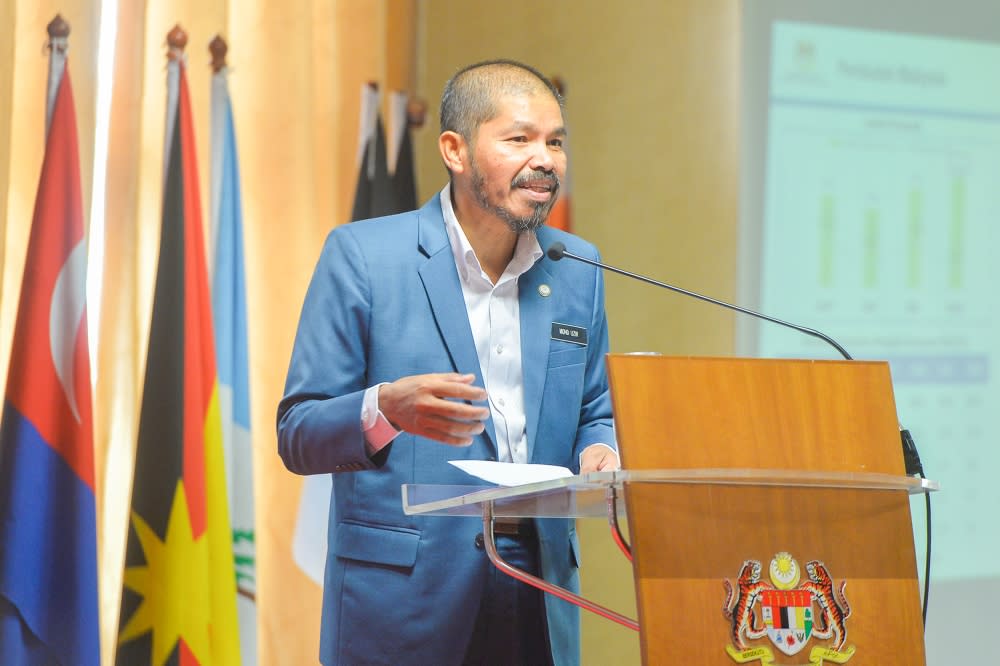Stats Dept: Malaysia’s average household income rises to RM8,479 in 2022

PUTRAJAYA, July 28 — The average household income in Malaysia experienced growth from RM7,901 in 2019 to RM8,479 in 2022, an increase accounted for a growth of 2.4 per cent over the three-year period, according to the Department of Statistics Malaysia (DoSM).
The Household Income and Expenditure Survey (HIES) 2022 report released by the chief statistician Datuk Seri Mohd Uzir Mahidin also revealed that the median household income in the country experienced an annual growth rate of 2.5 per cent, reaching RM6,338 in 2022.
“The income value takes into consideration the mean household size of 3.8 persons, with an average of 1.8 income earners.
“This household income comprises paid employment, self-employment, income from investment and current transfers received,” he said during the HIES report presentation here, today.
The data also revealed that six states surpassed the national median income level of RM6,338.
“Selangor recorded the highest median income growth of 6.5 per cent annually for the period between 2019 and 2022.
“However, Kuala Lumpur experienced a slight decline in monthly gross median household income by 1.0 per cent during the same period,” he said.
The states with median household incomes below the national average were Kelantan (RM3,614), Kedah (RM4,402), Perak (RM4,494), Sabah (RM4,577), Perlis (RM4,713), Pahang (RM4,753), and Sarawak (RM4,978).
On the other hand, Negri Sembilan, Terengganu and Melaka reported higher median household incomes, reaching RM5,226, RM5,878, and RM6,210, respectively.
Based on the analysis conducted by DoSM, the 10 districts with the lowest median household gross income, revealed that three of them were in Sabah, four in Sarawak, and three in Kelantan.
Among these districts, Pitas in Sabah recorded the lowest median household income, amounting to RM2,329, while the district of Sepang in Selangor emerged as the top earner with RM12,608.
Mohd Uzir also said that Putrajaya (RM13,473), Kuala Lumpur (RM13,325), Selangor (RM12,233), and Johor (RM8,517) have monthly mean gross household incomes higher than the national average.
Jurang ketidaksamarataan pendapatan semakin mengecil kepada 0.3% pada 2022.#StatsMalaysia#ARC2023#BE2023#BP2024#myagricensus#StatistikNadiKehidupan#StatistikSegalanyaPasti pic.twitter.com/l44s82incI
— DOSM (@StatsMalaysia) July 28, 2023
To address the government’s proposal on disposable income as the basis for assisting the people, the DoSM analysed the survey results from the perspective of disposable income.
“The mean monthly disposable household income increased by 1.7 per cent to RM7,111 compared to RM6,764 in 2019.
“Similarly, the mean monthly disposable household income for B40 households also rose by 1.9 per cent to RM5,413 from RM5,116 in 2019. Disposable household income constituted 83.9 per cent of the total gross household income,” he said.
Analysing income distribution patterns, the report highlighted that the B40 income threshold, covering 3.16 million households, is RM5,249.
The M40 group’s income ranged between RM5,250 to RM11,819, while the T20 group, comprising 1.58 million households, had incomes exceeding RM11,820.
“The T20 group accounted for 46.3 per cent of the total household income distribution, a slight decrease from 46.8 per cent in 2019. The M40 group accounted for 37.6 per cent, while the B40 group represented 16.1 per cent, slightly up from 16.0 per cent in 2019,” said Mohd Uzir.
Commenting on the HIES report, he said that the Gini Coefficient, which measures income inequality, showed a decrease from 0.407 in 2019 to 0.404 in 2022, indicating a narrowing income gap.
Despite the overall increase in household income, the report highlighted persistent income disparities between ethnic groups.
“The income gap between the Chinese and Bumiputera ethnic groups was 1:0.71 in 2022 compared to 1:0.72 in 2019. Similarly, the income gap between ethnic Chinese and Indians was 1:0.84 in 2022, showing marginal improvement from 1:0.83 in 2019,” he said.
Meanwhile, the report also highlighted a notable change in the Poverty Line Income (PLI), which increased to RM2,589 in 2022 as compared to RM2,208 in 2019 with the PLI value of food amounting to RM1,198 in 2022 compared to RM1,169 in 2019.
According to the survey results, the absolute poverty incidence increased to 8.4 per cent in 2020, slightly declining to 8.2 per cent in 2021, and further decreasing to 6.2 per cent in 2022.
Urban poverty incidence increased from 3.9 per cent in 2019 to 4.5 per cent in 2022, while rural poverty incidence decreased from 12.4 per cent to 12.0 per cent during the same period.
He added that the number of extremely poor households with income below RM1,198 decreased to 0.2 per cent (18,445 households) in 2022 from 0.4 per cent in 2019.



